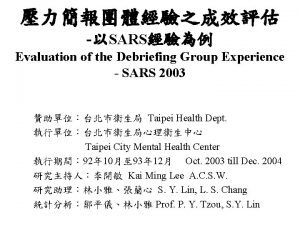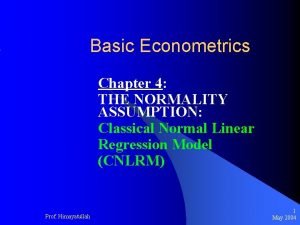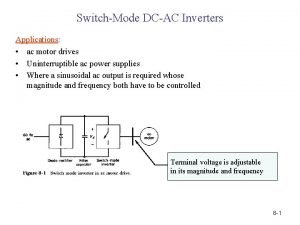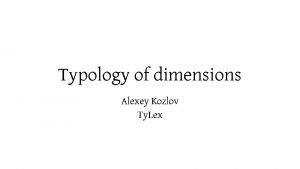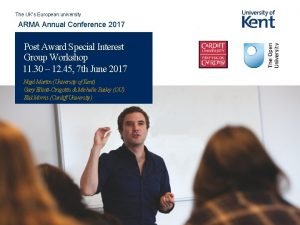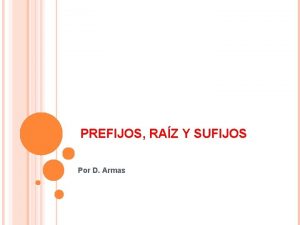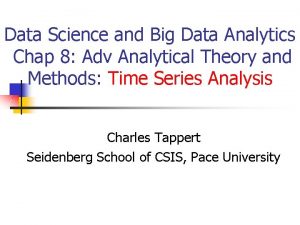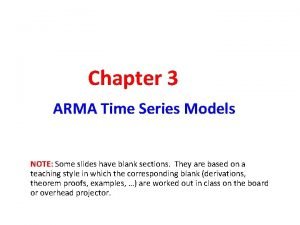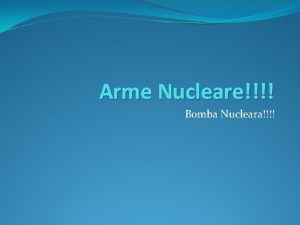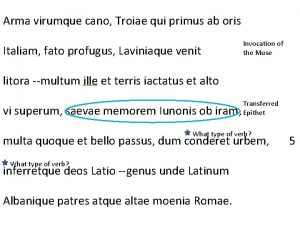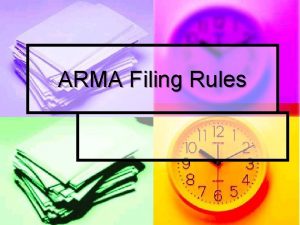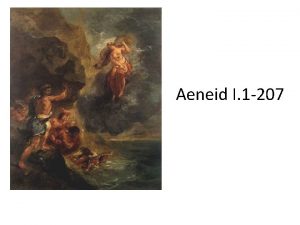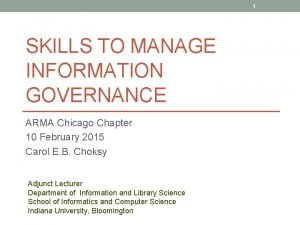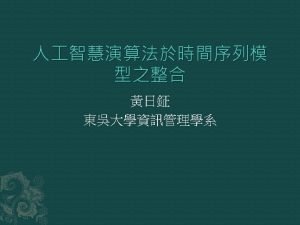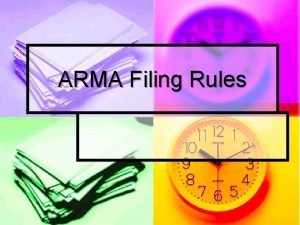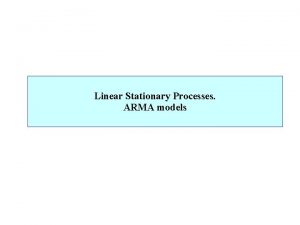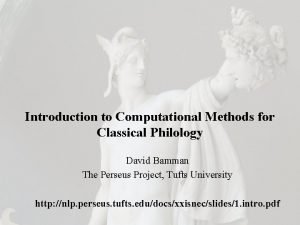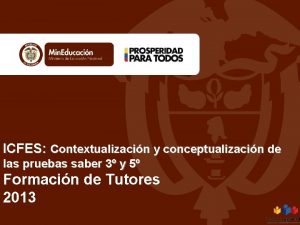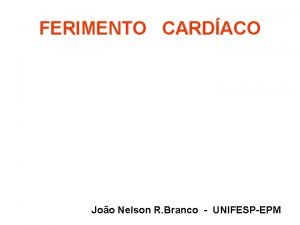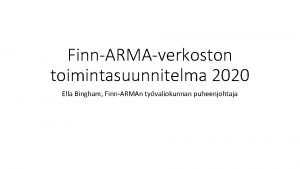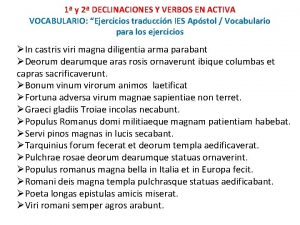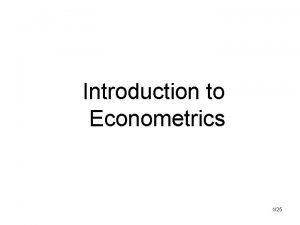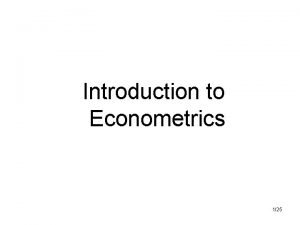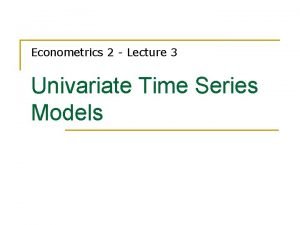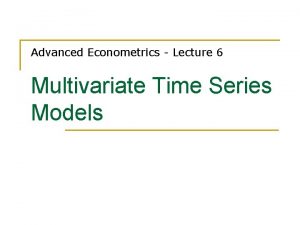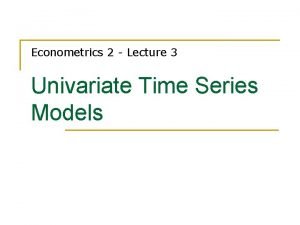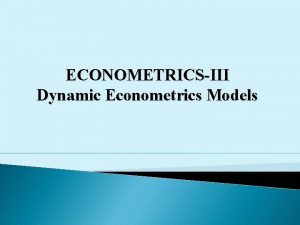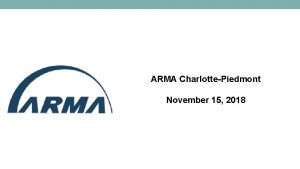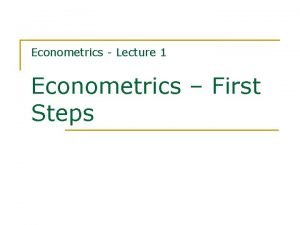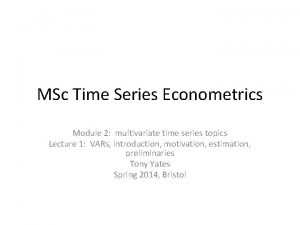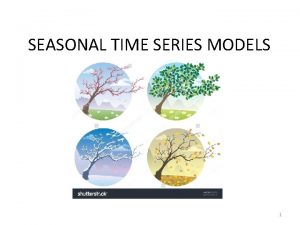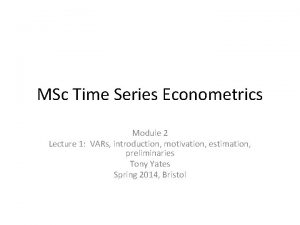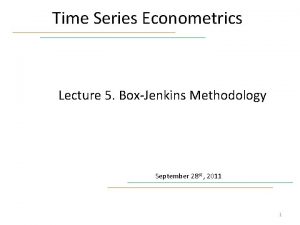Time Series Econometrics Lecture 3 ARMA Models Cont








































- Slides: 40

Time Series Econometrics Lecture 3. ARMA Models (Cont. ) September 14 st , 2011

Distribution of Random Variables Let h be the realized outcome of a fair coin flip Probability distribution of h Outcome Probability Head (1) 1/2 Tail (0) 1/2 Flipping the coin every minute and recording the outcomes ht={1 1 0……}

Quiz 1. Concept of Stationarity 1. Is the process {Yt} stationary? 2. What is the name of the process?

Quiz 1. Concept of Stationarity 1. Is the process {Yt} stationary? Yes Three conditions for stationarity 2. What is the name of the process? White noise

White Noise Purely random process: a series of uncorrelated random variables with mean zero and uniform variance.

Moving Average (MA)

Moving Average (1) • Expected value • Variance • Autocovariances • ACF The process is stationary

Moving Average: ACF Rule of thumb: ACF for MA (q) has q nonzero values and is equal to 0 for lags greater than q

Moving Average: ACF (Cont. )

Moving Average of Order q MA(q) Expected value • Variance For stationarity we need constant and finite variance If q is finite, this sum is finite too => MA(q) process is always

Moving Average: ACF MA(q) • Autocovariances • ACF Rule of thumb: ACF for MA(q) has q non-zero values and is equal to zero for lags greater than q

Moving Average: ACF (Cont. ) What is the order of the process? ρ(k) MA(3)

Autoregressive Process of Order One AR (1)

Autoregressive Process of Order One (Cont. ) AR (1)

AR(1): Stationarity AR (1) Successive substitutions Expected value is independent of t:

AR(1): Stationarity (Cont. ) • Variance Infinite geometric series with common factor a 1 Is variance finite? is explosive

AR(1): Stationarity (Cont. ) • Autocovariance • Autocorrelation N!B! Necessary condition for stationarity:

AR(1)

AR (1) ACF AR(1) with α 1>0

AR(1)

AR (1) ACF AR(1) with α 1<0

AR (2): Expected Value • Expected value If the process is stationary, E(Y t) = μ Necessary condition for the finite expected value is

AR (2): Variance is timeinvariant

AR (2): Variance • Autocorrelations For k > 2

AR (2)

Partial Autocorrelation Function PACF -Direct effect of Yt-2 on Yt -Indirect effect: effect of Yt-2 on Yt-1 and consequent effect of Yt-1 on Yt Derivation Yule-Walker Equations If ρs were known, we could calculate α , α

AR (2) ACF for AR(2) is sinusoidal and geometrically damped

AR (2) ACF

AR (2) ACF

AR(1) 30

AR(2) 31

MA(1) 32

MA(2) 33

Autoregressive Moving Average Models ARMA (p, q) processes AR(p) is a special case of ARMA(p, 0) MA(q) is a special case of ARMA(0, q) ARMA(1, 1) Expected value Necessary condition for stationarity:

ARMA(1, 1) • Variance • Covariance • ACF

ARMA(1, 1)

ARMA(1, 1)

38

39

Next Lecture Topic: Non-Stationary TS and Transformation to Stationarity ! Reading assignment for next week Enders , Chapter 2, pp. 67 -82. Deriving variance, covariances and correlations for AR (1)-(2), MA(1)-(2), and ARMA(1, 1).
 Debriefing report
Debriefing report Cont or cont'd
Cont or cont'd Cnlrm
Cnlrm 01:640:244 lecture notes - lecture 15: plat, idah, farad
01:640:244 lecture notes - lecture 15: plat, idah, farad Geology lecture series
Geology lecture series Dcac lecture series
Dcac lecture series Modals and semi modals
Modals and semi modals Ibm p series servers
Ibm p series servers Start time end time and elapsed time
Start time end time and elapsed time Arma 3 whiteboard dimensions
Arma 3 whiteboard dimensions Arma conference 2017
Arma conference 2017 Familia de palabras de arma
Familia de palabras de arma Hexameter scansion
Hexameter scansion Poesia latina proemio iliade
Poesia latina proemio iliade Arima vs arma
Arima vs arma Cinturon negro arma blanca
Cinturon negro arma blanca Ma process
Ma process Arma nucleara definitie
Arma nucleara definitie Arma virumque cano troiae
Arma virumque cano troiae Arma filing rules
Arma filing rules Arma virumque cano troiae qui primus ab oris
Arma virumque cano troiae qui primus ab oris Arma information governance
Arma information governance Arma 3 toolkit
Arma 3 toolkit Arma pq
Arma pq Consecutiva implicita
Consecutiva implicita Bir tarihçi resmi belgelerdeki mühür arma
Bir tarihçi resmi belgelerdeki mühür arma Finn arma
Finn arma Sopa de letras del día de muertos
Sopa de letras del día de muertos Arma tu ofrenda
Arma tu ofrenda Arma indexing rules
Arma indexing rules Ma process
Ma process Computational philology
Computational philology Como se arma
Como se arma Moriamur et in media arma ruamus
Moriamur et in media arma ruamus Ninguna arma forjada
Ninguna arma forjada Clasificación de las heridas
Clasificación de las heridas Finarma
Finarma Projétil de arma de fogo
Projétil de arma de fogo Finn arma
Finn arma In castris viri magna diligentia arma parabant
In castris viri magna diligentia arma parabant Maclaurin series vs taylor series
Maclaurin series vs taylor series
